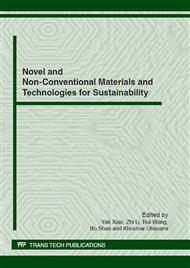p.189
p.197
p.203
p.208
p.213
p.217
p.222
p.227
p.233
Potentiality of Plaster Reinforced by Bamboo in Structural Elements
Abstract:
The world crosses an energetic, environmental and social crisis without precedents. Architecture and Engineering are also responsible because the more used industrialized construction materials, as Portland cement, concrete and steel, in their production process, demand a lot of energy, cause serious impacts to the environment and need big investments. One possibility to decrease this problem is the non compulsory employment of products based on Portland cement and steel, but also using local materials with which is possible to construct worthily. This work has as proposal the development of a structural gypsum element reinforced with bamboo that can be used as lintel and against-lintel in the constructions. Prisms samples (4cm x 4cm x 16cm) of gypsum matrix reinforced with bamboo rods were prepared and flexural tests were made. To improve bond between the two materials, treatments in the bamboo were tested. The tests showed that the most efficient material for this treatment was epoxy glue. Pre-fabricated structural peaces in real size were also tested through flexion tests in laboratory and applied in an prototype built in the University campus. The casting was made using vibratory table. Results show that vibrated bamboo reinforced gypsum is viable to be used in small structural beams and even replacing wood peaces in roofs.
Info:
Periodical:
Pages:
213-216
Citation:
Online since:
June 2012
Keywords:
Price:
Сopyright:
© 2012 Trans Tech Publications Ltd. All Rights Reserved
Share:
Citation:


